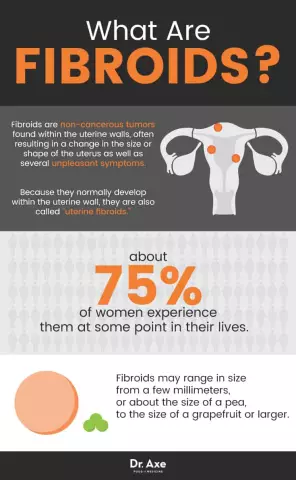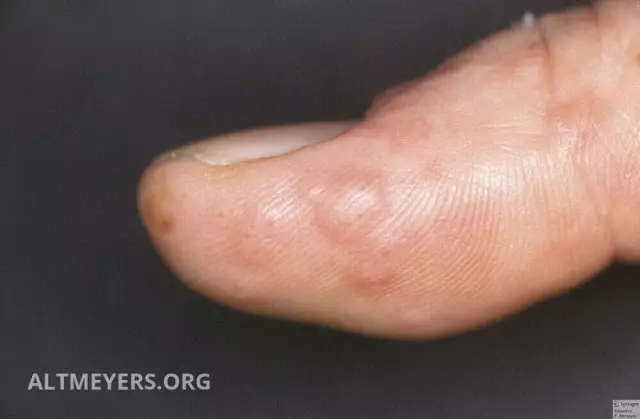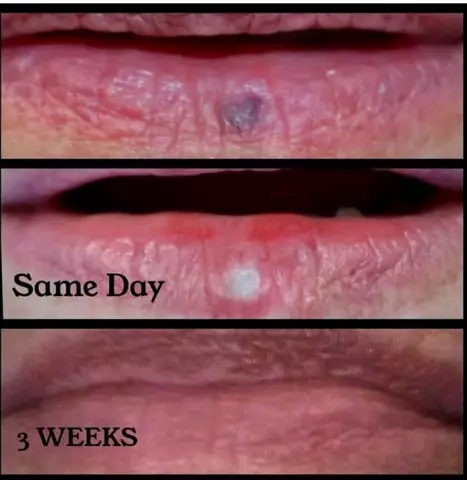- Author Rachel Wainwright [email protected].
- Public 2023-12-15 07:39.
- Last modified 2025-11-02 20:14.
Toxocariasis
General information about the disease
Toxocariasis belongs to the group of helminthic diseases caused by toxocara, a parasite that is very similar to the common human roundworm. The diameter of the toxocara larva is 0.02 mm. At the moment, experts know two types of it:
- toxosara mystax - feline helminth;
- tocsocara canis - affects dogs and other canids (wolves, arctic foxes, foxes).
People get toxocariasis mainly from dogs. According to the Russian Ministry of Health, toxocariasis in children is detected in every 2-3 children. In the United States, the incidence rate is much lower, but there are 800-1000 new people infected every year.
Sources of infection

Immediately, we note that people are only carriers of toxocariasis. It is impossible to become infected with toxocariasis from a sick person, since for toxocara, our body is an atypical habitat, and therefore they cannot reach a sexually mature state. Dogs are another matter entirely. In their bodies, toxocariasis develops to the fullest, and pathogens enter the external environment not only with feces, but also with animal hair. Studies carried out in some large cities in Russia have shown that parasite eggs are found in 10-30% of soil samples taken from streets, courtyards and parks.
How do toxocars enter the human body?
If among animals, intrauterine and transmammary (with mother's milk) routes of infection are often noted, then toxocariasis in humans manifests itself under the influence of exclusively external factors. You can get infected through food, animal hair, contaminated water, and unwashed hands. The main peak in the incidence of toxocorosis occurs in the summer, however, in general, new patients are detected throughout the year. The increase in the number of patients on hot days is explained by the fact that during this period the maximum number of eggs gets into the soil, and therefore the food.
Particular risk groups include: children who often play in the sand, veterinarians, grocery store sellers, hunters and dog breeders, owners of backyard plots.
Symptoms of toxocariasis disease
In the human body, parasites periodically migrate from one organs and systems to others. As a result, if the patient was not treated with the diagnosis of toxocariasis, or if he tried to get rid of helminths with the help of exclusively folk remedies, then the disease with toxocariasis acquires a long, recurrent nature. The clinical manifestations of the symptoms of toxocariasis depend on the state of the host's immune system, the intensity of infection and the form of the disease. It is worth dwelling on forms in more detail.
Cutaneous toxocariasis is manifested by all sorts of allergic skin reactions, edema, eczema, redness and itching in places where the larvae accumulate.
The visceral form of toxocariasis develops in the event that a large number of parasites have accumulated in the body. As a rule, visceral toxocariasis in children is more often detected, which is associated with the child's imperfect immunity. The main symptoms of toxocariasis include:
- abdominal syndrome (abdominal pain, diarrhea, nausea, vomiting);
- recurrent fever;
- shortness of breath, coughing, heavy breathing and other problems associated with impaired functioning of the respiratory system;
- an increase in the size of the liver;
- lymphadenopathy.
The neurological form of toxocariasis is diagnosed if toxocars penetrate the brain. This fact is evidenced by the following symptoms of toxocariasis:
- violation of attention;
- hyperactivity;
- difficulty reading;
- other neurological symptoms.
Toxocariasis in humans - the consequences and the myth about the effectiveness of self-medication
Let's say a few words about the consequences of the infection. Toxocariasis, the treatment of which began too late, leads to tissue injury, hemorrhages, necrosis, and inflammatory changes. With damage to the optic nerve, one-sided blindness may develop. In addition, toxocariasis often provokes the formation of numerous granulomas in vital organs and systems.
As for the folk treatment of toxocariasis and statements that toxocaras still die on their own and therefore you can safely self-medicate. In the human body, parasites, of course, die, but at the same time they still have time to cause significant harm. Therefore, when diagnosing toxocariasis, folk remedies should be used only as additional procedures to the main treatment. Otherwise, you run the risk of facing various complications of the infection, which will significantly affect the quality of life.
Toxocorosis treatment

In the treatment of toxocariasis, the drugs of choice are thiabendazole, mebendazole, and medamine. They are quite effective from the point of view of the destruction of migratory individuals, but practically do not affect the larvae that are in the granulomas of the internal organs. Albendazole fights against the latter, however, this drug has a strong hepatotoxic effect and therefore it can be taken only after consultation with your doctor. Ocular toxocariasis in children and adults is treated with subconjunctival depomedrol injections. In some cases, specialists make a decision on the need for surgical intervention.
Toxocariasis - folk remedies used in the course of treatment
Once again, pay attention to the fact that the alternative treatment of toxocariasis is used exclusively to alleviate the patient's condition and is not able to eliminate the cause of the infection. The following recipes are most widely used:
- Boil the head of garlic in milk and use the resulting mixture for cleansing enemas. The course of treatment lasts about a week;
- 1 tbsp. a spoonful of tansy flowers is poured with boiling water, boiled for 10-15 minutes and filtered. A decoction is administered with an enema once a day. Please note only that this remedy is not suitable if toxocorosis develops in children;
- fill in 3 tbsp. tablespoons of flowers and leaves of tansy with a glass of boiling water. Infuse the mixture for an hour. The medicine is taken 3-4 times a day for 1 tbsp. spoon;
- mix 1 tbsp. spoon wormwood seeds with honey and eat this mass between meals.
YouTube video related to the article:
The information is generalized and provided for informational purposes only. At the first sign of illness, see your doctor. Self-medication is hazardous to health!






